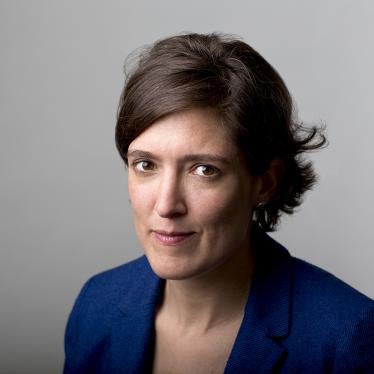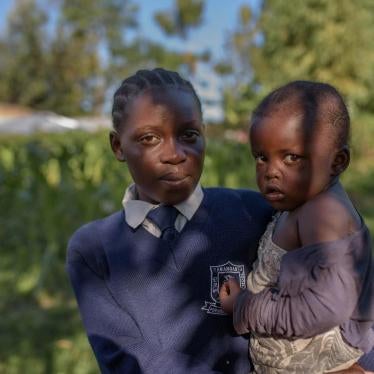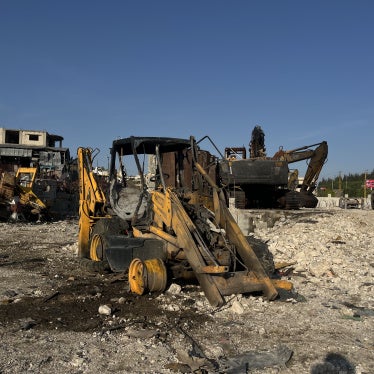“I thought I was dead,” Adam K. said, describing a mining accident the previous year, when he was 16 years-old. Adam, who started mining at age 12, was digging a horizontal mining shaft, deep in the ground. The tunnel collapsed in front of him, burying and killing two of his friends. “I was so scared,” he told me, “I just cried and despaired.”
But the accident didn’t stop Adam from mining. Having failed the exam at the end of primary school, which barred him from continuing his education, Adam had journeyed from one small-scale mine to another, seeking work where he could find it. When I met him in northwestern Tanzania, just south of Lake Victoria, he was working the night shift – 7p.m. to 7a.m. – digging another deep pit from the area’s red earth, using a pickaxe, shovel, and hammer. In return, he was paid with bags of rocks, which, if he was lucky, would contain traces of gold.
Thousands of children like Adam work in Tanzania’s small-scale gold mines, some as young as 8. (Small-scale mines are also called “artisanal,” although the work is a far cry from the elevated craftsmanship that word implies.) Following more than 200 interviews and other research over the last year, Human Rights Watch has found that children risk serious injury and even death from the work.
Like Adam, they dig in deep, unstable pits for shifts of up to 24 hours. They haul and crush heavy bags of gold ore into powder. And they process gold using toxic mercury, handling it with their bare hands, as Adam told me he did from age 14, and breathing in fumes when it is burned. Mercury, which is particularly harmful to children, attacks the central nervous system and can cause tremors and twitching, memory loss, and irreversible brain damage as well as damage to the kidneys and the lungs. A doctor in Papua New Guinea who treated small-scale miners for mercury poisoning, described his patients staring blankly at the wall as like “zombies.”
Tanzanian law prohibits mines from employing children under age 18. But the government has done little to enforce this prohibition, rarely inspecting small-scale mines or sanctioning those who hire children.
Many local gold traders, who then sell to other dealers or directly to exporters, buy openly from children. One trader told us, “I buy from anyone and I sell to anyone.”
Tanzania is the fourth-largest gold producer in Africa, and about 10 percent of its gold comes from small-scale mines. The United Arab Emirates is the top buyer, but Tanzania also exports gold to Switzerland, South Africa, China, and the United Kingdom. From there, it’s sold to refiners, and eventually to retailers for investment, jewelry, industry, and other uses.
But the problem isn’t limited to Tanzania – it’s common in many countries worldwide, particularly West Africa’s “gold belt,” where Human Rights Watch has conducted investigations in Mali and Ghana. Worldwide, about a million children work in all kinds of small-scale mines and quarries, the International Labor Organization estimates.
Mining is one of the most dangerous jobs in the world and should never be done by children. Gold buyers, refiners, retailers, and consumers, in turn, should not profit from unlawful child labor. We found little evidence that either domestic traders or international companies are doing nearly enough to detect and eliminate unlawful child labor in their supply chains. They should establish – and their buyers should demand – a thorough due diligence process so that their buyers can be confident their purchases are not the products of unlawful child labor or other abuses. All companies should include regular monitoring, and companies should visit artisanal mines to ensure they have accurate information.
The best way to make this a reality is for companies’ home governments to make human rights due diligence mandatory, and establish clear guidelines as to what it ought to look like. Boycotts are not the answer – they risk reducing the income of already impoverished artisanal mining communities and may even increase child labor as families become more desperate. Instead, companies, jointly with their local suppliers, could also initiate programs to transition children out of their supply chain.
Donors, which are significantly supporting and developing Tanzania’s mineral sector, should work to reduce child labor and mercury use in small-scale gold mining. The World Bank in particular, whose five-year, $50 million project covers many aspects of the country’s mineral sector, should include initiatives that target these areas. The ILO, which ended its focus on mining in 2010, should again make it a priority – it will need countries’ support to do that.
The Tanzanian government, in turn, should enforce its own laws that would keep children out of mines, improve support for orphans and other children especially at risk of being involved, strengthen access to education, and reduce the use of mercury. More broadly, all countries should ratify and implement the new Minamata Convention on Mercury, which opens for signature in October. This important new international treaty requires governments to develop plans to eliminate the most harmful forms of mercury use, promote mercury free mining methods, protect children and women of childbearing age from mercury exposure, and take steps to improve the health of miners.
People around the world profit from Tanzania’s gold as it is transformed into wealth, beautiful jewelry, and electronics. But for those, Adam pays a high price – he risks his health, and perhaps his life, in exchange for a bag of rocks.








